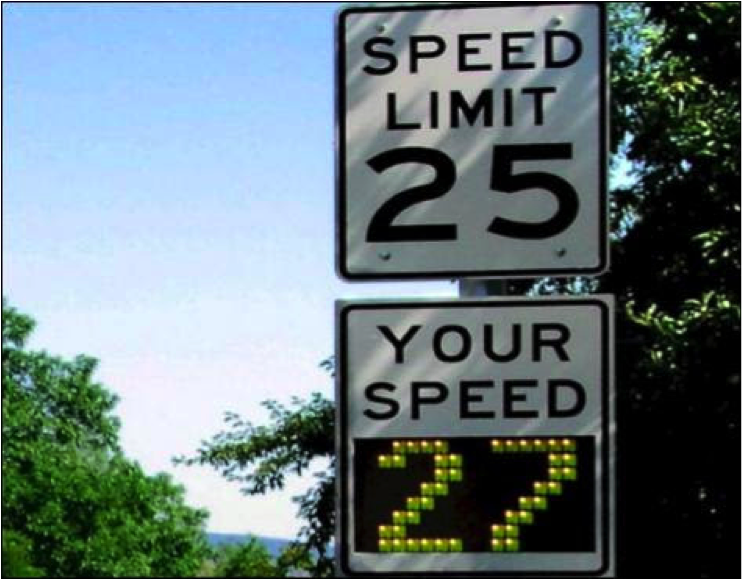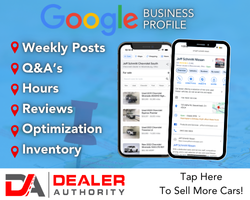The best way to change long-term behavior is with short-term feedback.
– Seth Godin
Government officials have tried long and hard to make streets around schools safer for pedestrians. In particular, for pedestrian children coming to and from school. We’ve all driven through one, yet it’s easy to take them for granted.
The idea of a school zone is simple: “We want you to slow down in these parts because we value our pedestrian children and parents”.
What’s interesting is how many ideas there are to encourage driver obedience in school zones that simply haven’t worked. Pasting a neon strip on a standard speed limit sign didn’t help. Adding a flashing light didn’t help. Using a police officer to monitor every school zone in America equates to panicked drivers and a huge tax bill.
Then a school district tried this:

These dynamic Your Speed signs have had a big impact on driver behavior. Suddenly, people slowed down. They complied with the speed limits. They became more alert and safer drivers.
Isn’t that weird? You already have a useful Your Speed sign included in your automobile called a speedometer. There isn’t a penalty for driving too fast either. It’s not like the digital sign tracks your identity and sends you a citation.
Why do we slow down then?
The sign is a brilliant example of an effective feedback loop. What’s a feedback loop? Put simply:
Gives people immediate feedback on their actions –> Creates an opportunity to adjust those actions –> Guides them toward a desired behavior.
Let’s take a closer look at the Your Speed sign. It displays several elements of a feedback loop:
Step 1: The current behavior must be measured, captured and stored.
The radar does this by capturing your speed.
Step 2: The collected data is then instantly shared with you.
The sign does this with an immediate representation of your speed.
Step 3: The information should illuminate a desired path.
The Your Speed sign makes this obvious by stacking your speed below the posted limit. It provides context for your speed and desired speed.
Step 4: The action becomes a new habit.
If you drive through a school zone every morning, there is a good chance you will naturally slow down subconsciously, even on a Saturday.
Who else?
Everyone from sales teams, to Fortune 500 mega companies, to technology startups are using feedback loops to sell more, market better and build better products.
You don’t need to look very far for other good instances of feedback loops. For one, try your phone or tablet. Have any of those crazy addicting Zynga games on there? What about Candy Crush? Or Words with Friends?
One my favorite examples is the Nike FuelBand, along with many other wearable fitness technologies. My behavior is measured and collected. It’s immediately accessible. My path to goal completion is clearly illuminated. I’m even benchmarked against others. I build habits based on collecting these Fuel Points. I subconsciously choose the stairs over the elevator. I park my car further away. My work breaks are full of steps.
 Here is a little secret: The FuelBand didn’t teach me how to exercise. I knew how to walk, jog and play before wearing it. But all of the sudden, when a tight feedback loop serves me interesting and relevant data, I’m pressing on to gain Fuel Points.
Here is a little secret: The FuelBand didn’t teach me how to exercise. I knew how to walk, jog and play before wearing it. But all of the sudden, when a tight feedback loop serves me interesting and relevant data, I’m pressing on to gain Fuel Points.
So what?
That’s a fair question. A sound perspective on technology and software development is asking what impact it has on creating an ideal end user. Good feedback loops help us get there. They provide incredible insight into human behavior and how we can motivate people to do good things in our jobs and personal lives.
Look at the four steps above and ask yourself if you exhibit any of those in your sales efforts or product development. Ask yourself these questions:
* Are you providing relevant data to your employees or end users?
* Are you using benchmarks to provide context for success?
* Are you not only collecting data, but giving it back to employees or users in a meaningful way?
* Are you consistent and timely with your feedback?
* Do you truly understand what the desired action of your end user is?
As Seth Godin says, “”The best way to change long-term behavior is with short-term feedback.”








